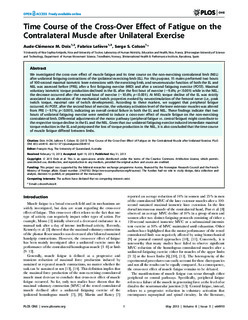| dc.contributor.author | Doix, Aude-Clémence | |
| dc.contributor.author | Lefevre, F | |
| dc.contributor.author | Colson, SS | |
| dc.date.accessioned | 2015-11-20T11:12:01Z | |
| dc.date.accessioned | 2016-06-22T10:27:45Z | |
| dc.date.available | 2015-11-20T11:12:01Z | |
| dc.date.available | 2016-06-22T10:27:45Z | |
| dc.date.issued | 2013 | |
| dc.identifier.citation | PLoS ONE 2013, 8(5) | nb_NO |
| dc.identifier.issn | 1932-6203 | |
| dc.identifier.uri | http://hdl.handle.net/11250/2393629 | |
| dc.description.abstract | We investigated the cross-over effect of muscle fatigue and its time course on the non-exercising contralateral limb (NEL) after unilateral fatiguing contractions of the ipsilateral exercising limb (EL). For this purpose, 15 males performed two bouts of 100-second maximal isometric knee extensions with the exercising limb, and neuromuscular function of both the EL and NEL was assessed before (PRE), after a first fatiguing exercise (MID) and after a second fatiguing exercise (POST). Maximal voluntary isometric torque production declined in the EL after the first bout of exercise (−9.6%; p<0.001) while in the NEL, the decrease occurred after the second bout of exercise (−10.6%; p<0.001). At MID, torque decline of the EL was strictly associated to an alteration of the mechanical twitch properties evoked by neurostimulation of the femoral nerve (i.e., peak twitch torque, maximal rate of twitch development). According to these markers, we suggest that peripheral fatigue occurred. At POST, after the second bout of exercise, the voluntary activation level of the knee extensor muscles was altered from PRE (−9.1%; p<0.001), indicating an overall central failure in both the EL and NEL. These findings indicate that two bouts of unilateral fatiguing exercise were needed to induce a cross-over effect of muscle fatigue on the non-exercising contralateral limb. Differential adjustments of the motor pathway (peripheral fatigue vs. central fatigue) might contribute to the respective torque decline in the EL and the NEL. Given that our unilateral fatiguing exercise induced immediate maximal torque reduction in the EL and postponed the loss of torque production in the NEL, it is also concluded that the time course of muscle fatigue differed between limbs. | nb_NO |
| dc.language.iso | eng | nb_NO |
| dc.publisher | Public Library of Science | nb_NO |
| dc.rights | Navngivelse 3.0 Norge | * |
| dc.rights.uri | http://creativecommons.org/licenses/by/3.0/no/ | * |
| dc.title | Time Course of the Cross-Over Effect of Fatigue on the Contralateral Muscle after Unilateral Exercise | nb_NO |
| dc.type | Journal article | nb_NO |
| dc.type | Peer reviewed | nb_NO |
| dc.date.updated | 2015-11-20T11:12:01Z | |
| dc.source.volume | 8 | nb_NO |
| dc.source.journal | PLoS ONE | nb_NO |
| dc.source.issue | 5 | nb_NO |
| dc.identifier.doi | 10.1371/journal.pone.0064910 | |
| dc.identifier.cristin | 1044826 | |
| dc.description.localcode | © 2013 Doix et al. This is an open-access article distributed under the terms of the Creative Commons Attribution License, which permits unrestricted use, distribution, and reproduction in any medium, provided the original author and source are credited. | nb_NO |

